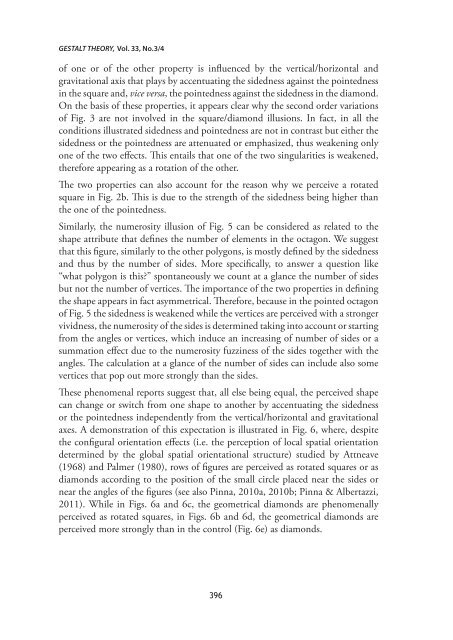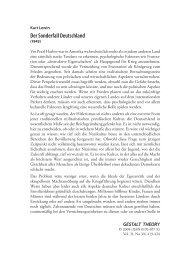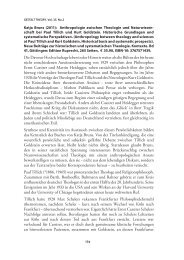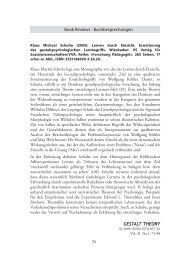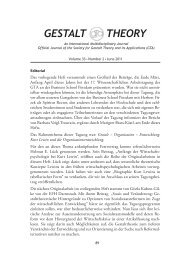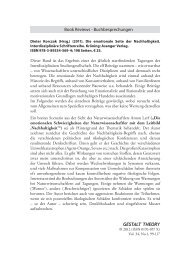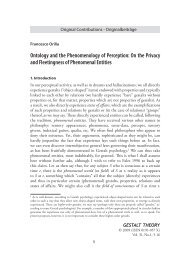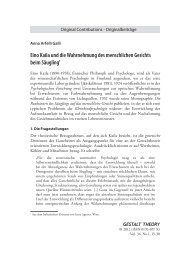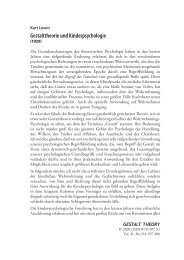What is the Meaning of Shape? - Gestalt Theory
What is the Meaning of Shape? - Gestalt Theory
What is the Meaning of Shape? - Gestalt Theory
Create successful ePaper yourself
Turn your PDF publications into a flip-book with our unique Google optimized e-Paper software.
GESTALT THEORY, Vol. 33, No.3/4<br />
<strong>of</strong> one or <strong>of</strong> <strong>the</strong> o<strong>the</strong>r property <strong>is</strong> influenced by <strong>the</strong> vertical/horizontal and<br />
gravitational ax<strong>is</strong> that plays by accentuating <strong>the</strong> sidedness against <strong>the</strong> pointedness<br />
in <strong>the</strong> square and, vice versa, <strong>the</strong> pointedness against <strong>the</strong> sidedness in <strong>the</strong> diamond.<br />
On <strong>the</strong> bas<strong>is</strong> <strong>of</strong> <strong>the</strong>se properties, it appears clear why <strong>the</strong> second order variations<br />
<strong>of</strong> Fig. 3 are not involved in <strong>the</strong> square/diamond illusions. In fact, in all <strong>the</strong><br />
conditions illustrated sidedness and pointedness are not in contrast but ei<strong>the</strong>r <strong>the</strong><br />
sidedness or <strong>the</strong> pointedness are attenuated or emphasized, thus weakening only<br />
one <strong>of</strong> <strong>the</strong> two effects. Th<strong>is</strong> entails that one <strong>of</strong> <strong>the</strong> two singularities <strong>is</strong> weakened,<br />
<strong>the</strong>refore appearing as a rotation <strong>of</strong> <strong>the</strong> o<strong>the</strong>r.<br />
The two properties can also account for <strong>the</strong> reason why we perceive a rotated<br />
square in Fig. 2b. Th<strong>is</strong> <strong>is</strong> due to <strong>the</strong> strength <strong>of</strong> <strong>the</strong> sidedness being higher than<br />
<strong>the</strong> one <strong>of</strong> <strong>the</strong> pointedness.<br />
Similarly, <strong>the</strong> numerosity illusion <strong>of</strong> Fig. 5 can be considered as related to <strong>the</strong><br />
shape attribute that defines <strong>the</strong> number <strong>of</strong> elements in <strong>the</strong> octagon. We suggest<br />
that th<strong>is</strong> figure, similarly to <strong>the</strong> o<strong>the</strong>r polygons, <strong>is</strong> mostly defined by <strong>the</strong> sidedness<br />
and thus by <strong>the</strong> number <strong>of</strong> sides. More specifically, to answer a question like<br />
“what polygon <strong>is</strong> th<strong>is</strong>?” spontaneously we count at a glance <strong>the</strong> number <strong>of</strong> sides<br />
but not <strong>the</strong> number <strong>of</strong> vertices. The importance <strong>of</strong> <strong>the</strong> two properties in defining<br />
<strong>the</strong> shape appears in fact asymmetrical. Therefore, because in <strong>the</strong> pointed octagon<br />
<strong>of</strong> Fig. 5 <strong>the</strong> sidedness <strong>is</strong> weakened while <strong>the</strong> vertices are perceived with a stronger<br />
vividness, <strong>the</strong> numerosity <strong>of</strong> <strong>the</strong> sides <strong>is</strong> determined taking into account or starting<br />
from <strong>the</strong> angles or vertices, which induce an increasing <strong>of</strong> number <strong>of</strong> sides or a<br />
summation effect due to <strong>the</strong> numerosity fuzziness <strong>of</strong> <strong>the</strong> sides toge<strong>the</strong>r with <strong>the</strong><br />
angles. The calculation at a glance <strong>of</strong> <strong>the</strong> number <strong>of</strong> sides can include also some<br />
vertices that pop out more strongly than <strong>the</strong> sides.<br />
These phenomenal reports suggest that, all else being equal, <strong>the</strong> perceived shape<br />
can change or switch from one shape to ano<strong>the</strong>r by accentuating <strong>the</strong> sidedness<br />
or <strong>the</strong> pointedness independently from <strong>the</strong> vertical/horizontal and gravitational<br />
axes. A demonstration <strong>of</strong> th<strong>is</strong> expectation <strong>is</strong> illustrated in Fig. 6, where, despite<br />
<strong>the</strong> configural orientation effects (i.e. <strong>the</strong> perception <strong>of</strong> local spatial orientation<br />
determined by <strong>the</strong> global spatial orientational structure) studied by Attneave<br />
(1968) and Palmer (1980), rows <strong>of</strong> figures are perceived as rotated squares or as<br />
diamonds according to <strong>the</strong> position <strong>of</strong> <strong>the</strong> small circle placed near <strong>the</strong> sides or<br />
near <strong>the</strong> angles <strong>of</strong> <strong>the</strong> figures (see also Pinna, 2010a, 2010b; Pinna & Albertazzi,<br />
2011). While in Figs. 6a and 6c, <strong>the</strong> geometrical diamonds are phenomenally<br />
perceived as rotated squares, in Figs. 6b and 6d, <strong>the</strong> geometrical diamonds are<br />
perceived more strongly than in <strong>the</strong> control (Fig. 6e) as diamonds.<br />
396


